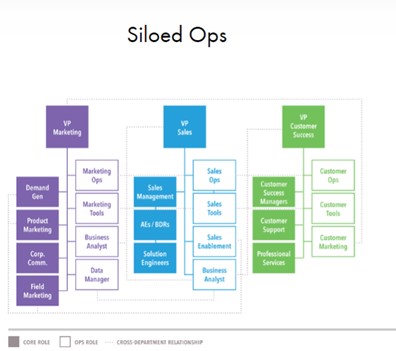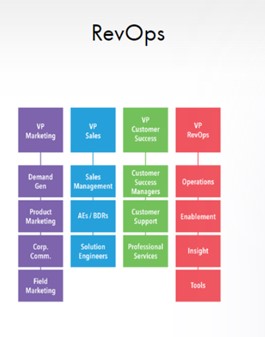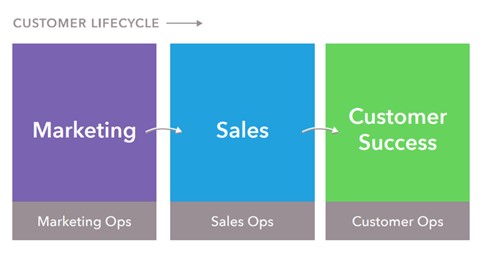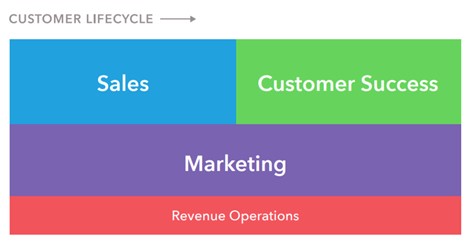Today’s fast-paced business climate makes it crucial, now more than ever, for companies to restructure their processes to gain a competitive edge.
For this reason, Revenue Operations, or RevOps, has become an increasingly popular function within organizations. Like everything else, it requires consistent updates and tweaking for it to generate sustainable growth.
Revenue Operations (RevOps) explained
At its core, RevOps is the alignment of a business’s siloed sales, marketing, and customer success operations. This alignment should span across the company’s entire customer life cycle and aims to drive growth through operational efficiency.
Experts on the topic agree that the secret to revenue operation’s success is its holistic approach in lining up a company’s focus, which is often revenue optimization. This practice can only be successful when customer-facing departments prioritize inter-departmental efficiency and making each other accountable for the processes where they work together.
A company working in Siloed Ops
Within every organization, there are multiple departments. Even the smallest of companies must segment their operations according to the subject matter, the data they manage, and their contribution to its overall success.
Before the boom in revenue operations for B2B, most organizations operate under the silo model. The silo mentality is essentially a reluctance to share information with employees of different divisions in the same company…it is seen as reducing the organization’s efficiency and, at worst, contributing to a damaged corporate culture.
In this model, each department is led by a different individual, the VP of Marketing, VP of Sales, VP of Customer Success, and VP of Operations. They are responsible for ensuring that some information is given cross-departmental access.
This dynamic stems from the idea that departments address different aspects and issues of a company, and therefore do not require much cross-departmental communication. This is, of course, an erroneous idea because it can lead to a lag in project completion and a lot of messes caused by miscommunication about information, tools, or processes.
The time siloed companies spend on cleaning up these messes could be invested in collaborating and creating effective strategies to generate more revenue. 
(Source: Chilipiper)
The RevOps Department
With RevOps, customer-facing departments involved in revenue optimization (marketing, sales, operations, and customer success) align their diverse objectives, priorities, and budgets to ensure they all strategically contribute to business growth.
This means that the RevOps team for each of these departments takes over the responsibility of generating steady revenue, while team members from other departments focus on the company’s clients.
Revenue operations are responsible for various processes for a smooth transition of information between departments.
RevOps can be broken down into multiple departments. These include the enablement team, insights team, operations management team, and tools team. Each team focuses on a different perspective and makes inter-department alignment easier to follow.
- Enablement team- focuses on eliminating friction between the sales, marketing, operations, and customer success teams, so that they can work more efficiently to satisfy the customer
- Insights team- provides the other departments with the hard data they require to make sound decisions
- Operations management team- helps manage and alleviate any setbacks for smooth collaboration between departments
- Tools team- is responsible for all of the technology and the tools that the sales, marketing, operations, and customer success teams use for their business process

(Source: Chilipiper)
The customer life cycle
The customer life cycle describes the various stages a consumer goes through before, during, and after they complete a transaction. In essence, it is the Point A to Point B journey a customer takes until they make a final purchase.
At Theia Marketing, we call this the client buying process. The marketing, sales, and customer success teams work together to ensure a prospect becomes a paying customer and an eventual brand advocate.
The stages of the customer life cycle include:
- Awareness- Your prospective client realizes they have a problem or an opportunity to fulfill.
- Consideration- The prospect identifies their problem and researches the available options.
- Decision- The prospect chooses a solution and makes a purchase.
- Post Decision/Advocacy- The client now evaluates their purchasing decision, and the vendor needs to cultivate a strong client relationship.
The customer life cycle and the Silo Ops
A company working under the silo framework will likely require one department to finish interacting with a prospect or customer before another can take on their role.
For example, sales will not know about a prospect until marketing considers that the individual is a sales-qualified lead (SQL). Only then will sales have the authority to interact with them. Once the lead becomes a customer, the customer success team can be worth it to ensure their user experience with the company brand is positive.
 (Source: Getfunnelcake)
(Source: Getfunnelcake)
The customer life cycle and RevOps
In contrast, the RevOps interpretation of the customer life cycle changes the dynamics between departments. Revenue operations help drive each department’s efforts to guide potential clients to make a purchase eventually.
Marketing is responsible for driving new business and up-selling opportunities and preventing churn from promoting customer retention.
The sales department is involved in the early stages of the customer life cycle through prospecting and sales-centered outbound campaigns to generate awareness.
The customer success team interacts with prospects answering any questions they may have about the product’s specifications, pricing, or shipping.
RevOps helps align other departments such as finance, product, and business development leaders to ensure the customer life cycle is enhanced to gain more clients and increase revenue.
 (Source: Getfunnelcake)
(Source: Getfunnelcake)
The top benefits of RevOps
When implemented effectively, a RevOps approach to business processes can produce various benefits. These include the following:
- Streamlined operations: RevOps has become widespread in the business world for a reason. It increases a company’s overall efficiency and removes possible roadblocks between departments that could be hindering the customer experience.
- Greater focus on objectives across teams: The issue with the silo model is that each department may have its own goals and metrics with which they measure success. Sometimes these can contradict the objectives of other customer-facing departments.
With a revenue operations approach, departments collectively achieve the goals related to the customer experience, including generating high-quality, making sales, and generating more sustainable revenue. - Sustainable business growth: When team leaders agree on the interconnection of departments allows for a smoother transfer of ideas, data, and results, which will enable teams to determine which strategies work and which do not.
- Revenue growth: RevOps helps each department become more efficient in their processes. As a result, team members can focus on generating more revenue without requiring additional resources.
- Greater adaptation to any market changes: With inter-departmental collaboration, team members have access to the data, tools, project management, and training required to make smart decisions that reflect various aspects of a business. This means that any future change of focus or rebranding to stay competitive will be easier to manage.
Conclusion
What makes an organization successful is how well its individual parts work together to achieve an ultimate goal. This requires a collective focus and consistency to ensure that processes are up to date.
From a RevOps perspective, aligning its customer-facing units allows its leadership to prioritize what is actually important to a business, the customer.




